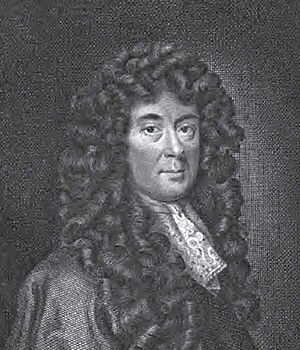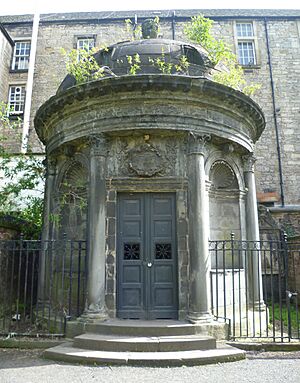George Mackenzie of Rosehaugh facts for kids
Sir George Mackenzie of Rosehaugh (1636 – May 8, 1691) was a Scottish lawyer, writer, and a very important government official called the Lord Advocate. He was sometimes known as Bloody Mackenzie because of how he treated certain religious groups.
Contents
Early Life and Education
George Mackenzie was born in Dundee, Scotland. His father was Sir Simon Mackenzie, and his mother was Elizabeth Bruce.
He went to several universities to study. He attended King's College at the University of Aberdeen starting in 1650. He also studied at the University of St Andrews in Scotland and the University of Bourges in France.
A Career in Law and Politics

In 1659, Mackenzie became a lawyer, joining the Faculty of Advocates. He quickly became known for his legal skills. For example, he helped defend Archibald Campbell, Marquis of Argyll in a big trial in 1661.
From 1661 to 1663, he worked as a justice-depute. This job meant he was involved in many trials, including those related to witchcraft.
Mackenzie was later given the title of "Sir." He also became a member of the Scottish Parliament, representing the County of Ross from 1669 to 1674.
In 1677, he was appointed Lord Advocate. This was a very powerful position, making him the chief legal officer for the King in Scotland. He also joined the Privy Council of Scotland, which was a group of advisors to the King.
The Covenanters and "Bloody Mackenzie"
As Lord Advocate, Sir George Mackenzie was responsible for carrying out the policies of King Charles II in Scotland. The King wanted everyone to follow the official church, but many Scottish people, known as Covenanters, wanted to practice their Presbyterian faith freely.
After a battle called Battle of Bothwell Bridge in 1679, Mackenzie ordered about 1,200 Covenanters to be imprisoned in a field next to Greyfriars Kirkyard in Edinburgh. Many of them suffered greatly, and some died. This period was very difficult for the Covenanters, and Mackenzie's actions during this time led to his nickname, "Bluidy Mackenzie."
Some people believed he was just following the law strictly. The nickname "Bluidy" became well-known later, appearing in books like The Heart of Midlothian (1818).
Mackenzie briefly left his role in 1686 but returned in 1688. He continued to serve in Parliament for Forfarshire. However, he disagreed with the decision to remove King James II from power during the Glorious Revolution. Because of this, he decided to retire from public life.
Later Years and Legacy
Sir George Mackenzie spent most of his life in a large house in Edinburgh, close to the Scottish Parliament.
After retiring, he moved to Oxford in England. He died in Westminster on May 8, 1691. He was buried in Greyfriars Kirkyard in Edinburgh. His tomb, called a mausoleum, was designed by a famous architect named James Smith.
Mackenzie's Writings
Beyond his legal and political career, Mackenzie was also a talented writer. He published Aretina in 1660, which some say was the first Scottish novel. He also wrote many thoughtful essays. People at the time described him as "learned" and "renowned."
He wrote many books on law, politics, and history, including:
- The Science of Heraldry (1680): This book was about heraldry, which is the study of coats of arms and family symbols.
- Institutions of the Law of Scotland (1684): A key book explaining Scottish law.
- Jus Regium (1684): This book strongly supported the idea of monarchy and the King's power.
- A Vindication of the Government in Scotland (1691).
- Antiquity of the Royal Line of Scotland (1686): About the history of Scotland's royal family.
- Memoirs of the Affairs of Scotland from the Restoration of Charles II (published in 1821, after his death).
Mackenzie was involved in witchcraft trials and wrote about his experiences. He believed that while some people might confess to witchcraft, it was often due to harsh questioning methods.
His book Laws and Customs of Scotland in Matters Criminal (1678) was the first textbook on Scottish criminal law. In it, he discussed the use of torture in legal cases, stating it was legal but rarely used.
Other works he wrote include:
- Religio Stoici (1663)
- A Moral Essay preferring Solitude to Public Employment (1665)
- Moral Gallantry (1667)
- The Moral History of Frugality (1691)
Founding the Advocates Library
One of Mackenzie's most important legacies is founding the Advocates Library in Edinburgh. This library was created for lawyers and scholars. He became the Dean of the Faculty of Advocates in 1682, and the library started operating in the early 1680s.
In Fiction
Sir George Mackenzie of Rosehaugh appears as a character in the novel Ringan Gilhaize, or The Covenanters (1823) by John Galt.
Family Life
In 1662, Mackenzie married Elizabeth Dickson. They had several children:
- John (died young)
- Simon (died young)
- George (died young)
- Agnes, who married James Stuart, who later became the 1st Earl of Bute.
- Elizabeth, who married Sir Archibald Cockburn and later Sir James Mackenzie, Lord Royston.
After Elizabeth died, Mackenzie married Margaret Haliburton in 1670. They had a son and two daughters:
- George, who married but died before his father without male children.
- Anne, who married Sir William Dick.
- Elizabeth, who married Sir John Stuart.



